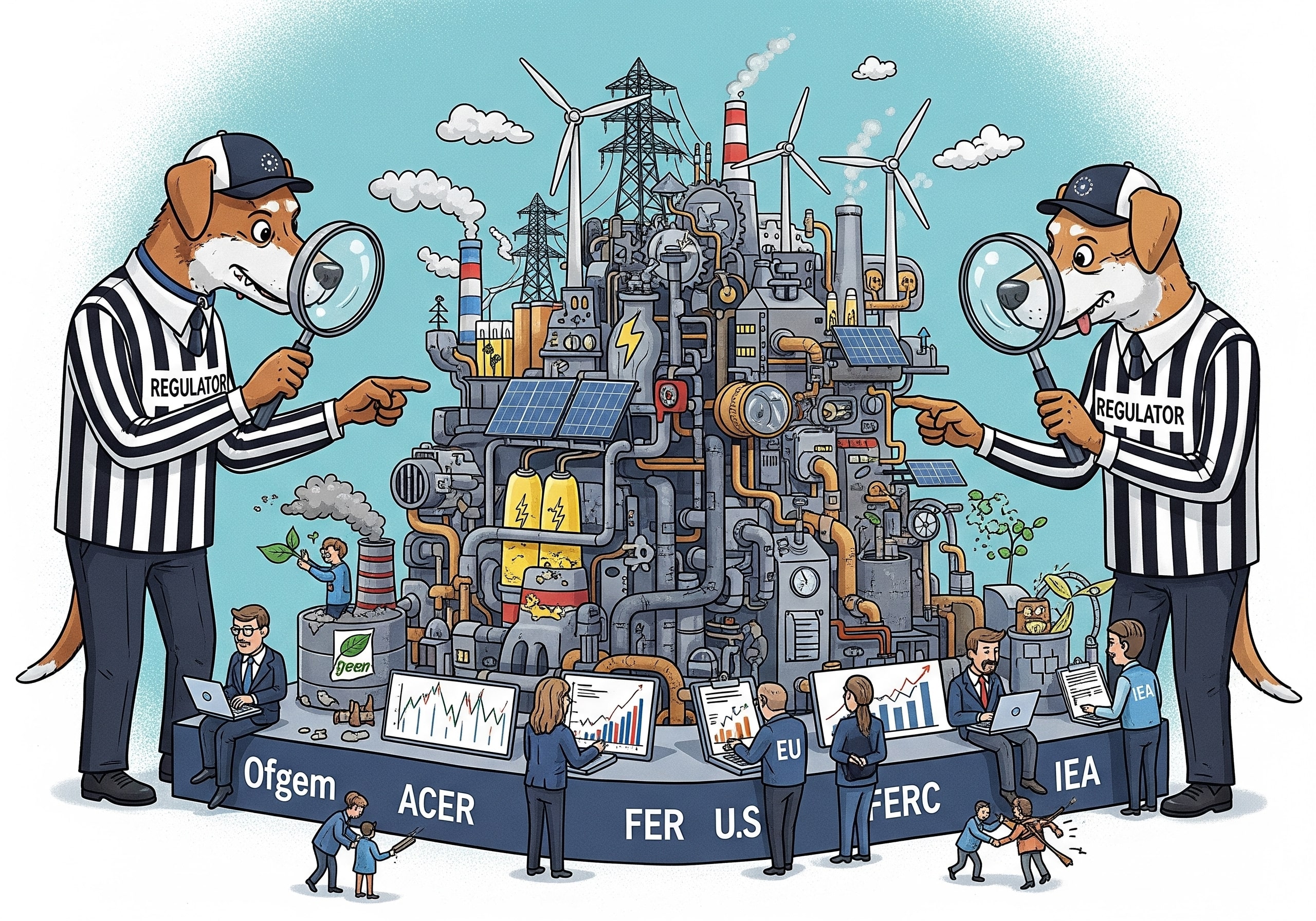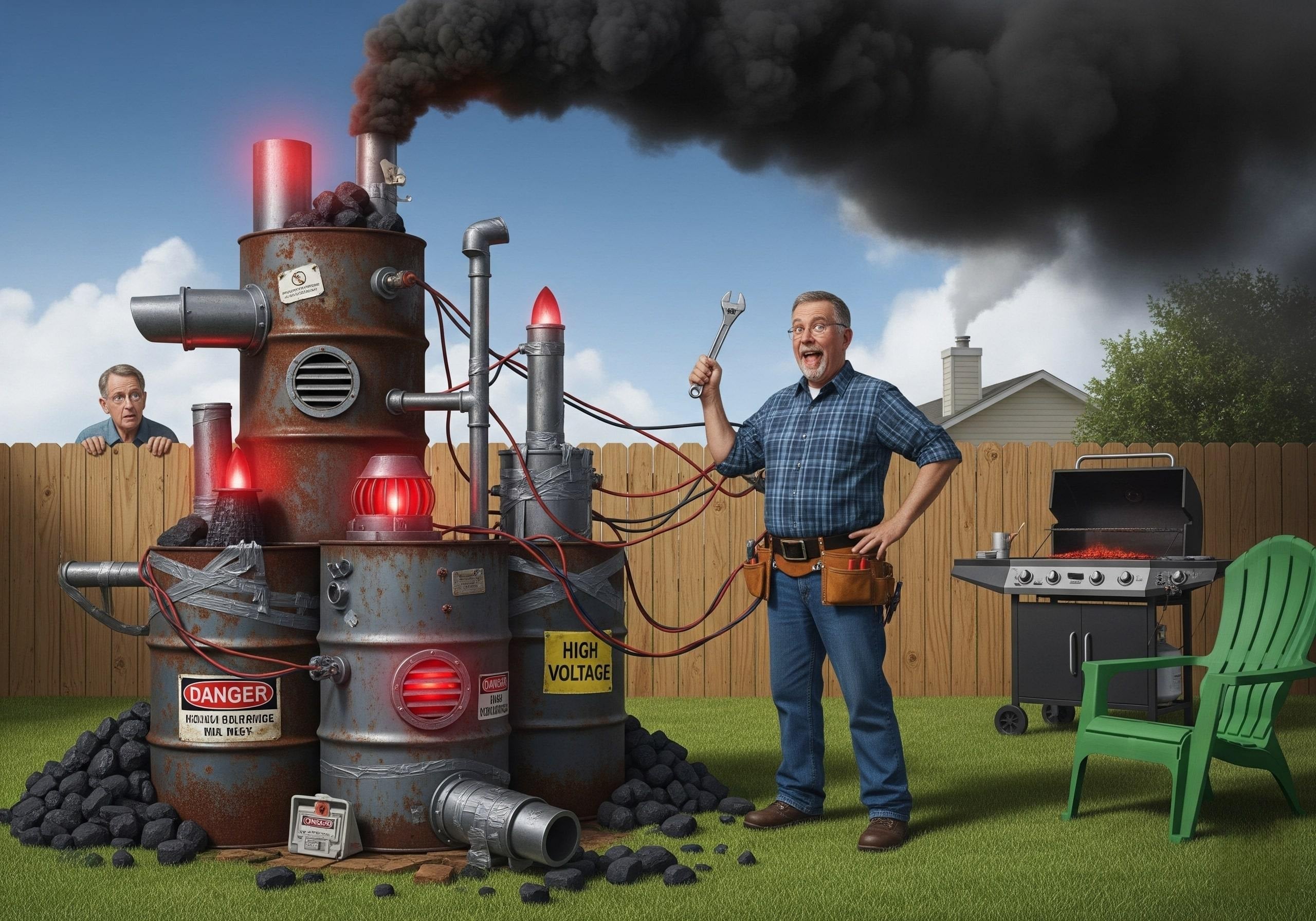Imagine a city with no traffic rules. None. Zero. Zilch.
Cars zip through intersections like they’re auditioning for an action movie. Buses park wherever the driver feels a spiritual connection. Motorbikes thread between lanes. Cyclists? They’re praying. And pedestrians? They’ve evolved into Olympic sprinters.
Making it to work on time? Forget it. You’re lucky just to make it in one piece.
Now picture this: the mayor of this wild town is your buddy. They ask for advice. You’d probably yell, “You need to regulate the traffic, man! Put up signs, mark crosswalks, fine people who break the rules!”
Obvious, right? But here’s the kicker—energy works the same way.
Now replace ‘traffic’ with ‘energy’
Think of it this way: imagine if anyone could build a power plant wherever they wanted. Bob could stick a nuclear reactor next to your local swimming pool. Sarah might run a gas pipeline through a kindergarten. Dave, who once lit his garage on fire trying to deep-fry a turkey, might start his own coal plant in the backyard.
Meanwhile, power companies could charge whatever they wanted. Want electricity in July? That’ll be $900 a minute. Need to boil water for tea? Better take out a loan. And forget calling to complain—the CEO’s new yacht doesn’t get reception.
This is why we regulate
This is why we need energy regulation. Not because we love rules. But because we don’t want to wake up next to a uranium-powered smoothie shop or get an electric bill that reads like a ransom note.
Still curious how this all works? Good. Because we’re just getting warmed up.
Welcome to 1000whats—your backstage pass to the rules of power. Grab a coffee, flip a switch, and let’s untangle the energy world together. ⚡☕
What is energy regulation?
Energy regulation means setting rules for how energy is produced, transported, sold, and used.
Simple as that.
It’s like creating a playbook for an incredibly complex game—where the players are power plants, gas pipelines, solar panels, electric companies, and you.
Energy regulation means setting rules for how energy is made, moved, priced, and used.
In real life, energy regulation isn’t just a friendly suggestion. It’s an entire system of laws, bylaws, and government decisions that shape how the energy industry works.
Energy regulation in action: The greatest hits
If you stacked every energy regulation on paper, the pile would need its own zip code. Seriously—it’s rules on top of rules, covering everything from nuclear safety to how your toaster plugs in.
But let’s not get lost in the paperwork jungle.
To actually grasp what energy regulation looks like, let’s take a quick tour through some of the greatest hits—real rules that keep the lights on, the bills sane, and the neighbors from building backyard power plants.
Quality & safety standards
| Rule | What it means | Reality check |
| Gasoline quality control | Fuel must meet strict standards. Only legal “gasoline” can be sold at stations. | No swamp juice in your tank—regulators fine oil companies if they sneak in knock-offs. |
| Building codes | Homes must include insulation, efficient windows, and sometimes solar-ready roofs. | Without rules, you’d get a paper-thin apartment and freeze like a penguin in winter. |
| Power reliability | Utilities must keep voltage steady and upgrade the grid. | Otherwise, your fridge fries, your ice cream melts, and the utility buys you a new one. |
| Big picture safety | Dangerous infrastructure (like nuclear plants) must stay far from schools or homes. | No surprise uranium reactor next to your kid’s playground. Regulators make sure of it. |
Energy is powerful—but without safety rules, it can turn your ice cream into soup and your apartment into a freezer.
Environmental & climate rules
| Rule | What it means | Reality check |
| Emission caps | Power plants must filter emissions or pay fines. | No more Dickens-style smoke clouds blocking the sun. |
| Renewable energy quotas | A % of electricity must come from solar, wind, or hydro. | Like parents sneaking broccoli onto your dinner plate. |
| Climate commitments | Long-term targets push industries toward cleaner energy. | Otherwise, companies would still be burning dinosaur juice in the year 2100. |
Environmental rules are like seatbelts for the planet—annoying to some, but the reason we all survive the ride.
Price regulation
| Rule | What it means | Reality check |
| Household electricity tariffs | Regulators cap electricity prices so utilities can’t overcharge families. | Without this, your power bill could look like the GDP of a small country. |
| Fuel price ceilings | Governments set maximum prices for gasoline and diesel to avoid sudden shocks. | Filling your car shouldn’t feel like buying a designer handbag. |
Price regulation keeps your lights on without needing a bank loan every month.
Want the full story on the Energy price cap?
I unpacked it on 1000whats → https://1000whats.com/energy-price-cap/
Consumer protection
| Rule | What it means | Reality check |
| Billing transparency | Utilities must clearly explain how they calculate your bill. | No more mystery charges like “Service fee for existing.” |
| Universal service obligation | Even remote villages must get electricity or a minimum level of service. | Live at the end of a goat trail? Regulators still expect the lights to reach you. |
Consumer protection means you actually understand your bill—and still get electricity even if you live off the beaten path.
How does energy regulation work?
Alright, let’s talk about how those rules actually come to life.
Because, believe it or not, this isn’t just a bunch of politicians flipping coins in a dark room.
It happens in three big steps: setting the rules, monitoring them, and tweaking them when the world inevitably goes sideways.
Step 1: The rule-makers enter the scene
First, governments step in and say: “Alright folks, time for some laws.”
These can be big, sweeping national policies—like climate targets—or small, local rules, like where you’re allowed to plop a wind turbine.
Then the specialists show up: regulatory bodies. Independent agencies, commissions, or as I like to think of them: referees with clipboards and zero patience for nonsense.
They write the nitty-gritty playbooks:
- How much companies can charge
- How reliable the service must be
- How customers should be treated
- What emissions are allowed
- Where and how infrastructure gets built
And when someone breaks the rules? Penalties. Like traffic tickets—except instead of $100, it’s a few million and some very embarrassed executives.
Step 2: Monitoring, measuring, and magnifying glasses
Once the rules are written down, the real question is: “Is anyone actually following them?”
That’s where monitoring comes in. The energy system is massive—like a machine with a million moving parts—and it has its own watchdogs. These watchdogs are energy agencies, whose entire job is to make sure companies play by the book.
Every country has one. And some even work across borders:
- In the UK, it’s Ofgem, making sure companies don’t overcharge customers or fry the grid.
- In the EU, it’s ACER, which watches over cross-border energy markets—so one country can’t hog all the electricity like the greedy kid at recess.
- In the U.S., you’ve got FERC (Federal Energy Regulatory Commission). They set the rules for interstate electricity, natural gas, and pipelines—so states don’t start an energy food fight.
- Globally, the IEA (International Energy Agency) steps in as more of a data wizard—tracking trends, crunching numbers, and advising governments on how to keep the lights on without frying the planet.
These agencies track everything: prices, emissions, outages, and whether companies are actually investing in renewables or just greenwashing with a fancy logo.
They’re the magnifying glass over the industry—spotting problems before your fridge melts into a puddle of warm yogurt.
Energy agencies are the hall monitors of the power world—only their detentions cost millions.
Need a full list of regulatory bodies across the globe? Here’s a superb resource: https://en.wikipedia.org/wiki/List_of_energy_regulatory_bodies on Wikipedia.

Step 3: Adjusting the system (Because stuff changes)
Energy isn’t a “set it and forget it” business. It’s not a frozen lasagna—you can’t just leave it in the oven and hope for the best.
Technology evolves. Prices bounce around. Geopolitics flare up. Sometimes, a volcano sneezes ash and half a continent goes dark. When that happens, regulators don’t just shrug—they tweak the rules.
How do they do it?
- They consult experts (the science folks with spreadsheets).
- They talk to industry (the companies who actually keep the grid humming).
- And sometimes, they even ask the public (because angry citizens with blackout candles are very persuasive).
If something’s broken—boom, new rule.
If something’s working—double down.
It’s a living system. Flexible, evolving, and always trying to keep the lights on without setting your wallet—or the planet—on fire.
Examples in action:
- When solar panels got cheap, regulators changed the rules so renewable energy gets first dibs on the grid—like letting ambulances cut the line in traffic.
- After the 2003 U.S.-Canada blackout, reliability standards were overhauled so one sagging power line wouldn’t cascade into chaos.
- When Russia cut off gas supplies to Europe, the EU scrambled to update its energy security rules practically overnight.
Energy rules aren’t carved in stone—they bend, stretch, and adapt every time the world throws a curveball.
Final thoughts
Energy regulation might not have the glitz of Hollywood—no capes, no car chases—but it’s the quiet scaffolding that holds our modern world together. It decides how much you pay for coffee, how stable economies remain, and how fair the energy game is for both people and the planet.
This isn’t a finished story, either. The script is still being written, line by line. New technologies pop up, climate pressures intensify, and public voices refuse to stay in the background. The rules of power—literally—are evolving. And here’s the kicker: you’re not just in the audience, you’re part of the writing team.
Your turn on stage
So let’s flip the spotlight:
- How should governments juggle the tightrope between affordable prices and clean energy goals?
- Should citizens have a more direct say—maybe even voting—on big energy policies?
- What role should global groups like the IEA or UN play in shaping national rules?
The final curtain (for now)
Your thoughts aren’t just chatter. They’re part of the conversation shaping our shared energy future. Think of it like co-writing the playbill for tomorrow’s performance.
The rules of energy are still being written—and every one of us holds a pen.
Until next time: stay curious, stay plugged in, and maybe—just maybe—keep an eye on your toaster.
P.S. If Dave ever does build that coal plant, I’ll write a post about it. 😂

